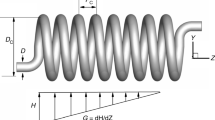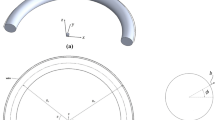Abstract
This paper experimentally investigates the effects of constant magnetic field on the average Nusselt number variation when the water-based ferrofluid with 1 mass% Fe3O4 nanoparticles flows through a helically coiled pipe with constant wall temperature in various Reynolds numbers. The two-step method has been utilized for ferrofluid preparation. In order to increase the heat transfer coefficient of the system, both active and passive methods are employed simultaneously. Changing the pipe shape to a helical configuration and adding magnetic nanoparticles in the fluid flow are two passive methods, while the active method is the exertion of a magnetic field. The convective heat transfer coefficient and pressure drop are two basic criteria in the evaluation of the results, and the main geometrical parameters are curvature and torsion ratios. The effects of fluid flow rate and the strength of the magnetic fields are also investigated. Applying a 600 G constant magnetic field, the results show the average Nusselt number augmentation of nearly 7%. In constant Reynolds number, the stronger magnetic field of 900 G yields a higher average Nusselt number.
















Similar content being viewed by others
Abbreviations
- A :
-
Area
- C p :
-
Specific heat
- \(\bar{h}\) :
-
Average heat transfer coefficient
- q s :
-
Heat transfer rate
- \(\Delta T_{\text{lm}}\) :
-
Logarithmic temperature difference
- \(\dot{m}\) :
-
Mass flow rate
- k :
-
Conductivity
- μ :
-
Viscosity
- ρ :
-
Density
- φ :
-
Nanoparticles mass fraction in the base fluid
- Nu :
-
Nusselt number
- Re :
-
Reynolds number
- f :
-
Friction factor
- T :
-
Temperature
- p :
-
Coil pitch
- d :
-
Pipe diameter
- D c :
-
Coil diameter
- \(\Delta P\) :
-
Pressure drop
- η :
-
Dimensionless parameter for optimization
- δ :
-
Uncertainty
- \({\text{bf}}\) :
-
Base fluid
- \({\text{nf}}\) :
-
Nanofluid
- \({\text{b}},{\text{o}}\) :
-
Bulk, outlet
- \({\text{b}},{\text{i}}\) :
-
Bulk, inlet
- \({\text{w}}\) :
-
Deionized water
- \({\text{c}}\) :
-
Coil
- \({\text{ave}}\) :
-
Average
References
Huminic G, Huminic A. Application of nanofluids in heat exchangers: a review. Renew Sustain Energy Rev. 2012;16:5625–38.
Wen D, Lin G, Vafaei S, Zhang K. Review of nanofluids for heat transfer applications. Particuology. 2009;7:141–50.
Rakhsha M, Akbaridoust F, Abbassi A, Majid S-A. Experimental and numerical investigations of turbulent forced convection flow of nano-fluid in helical coiled tubes at constant surface temperature. Powder Technol. 2015;283:178–89.
Suresh S, Chandrasekar M, Selvakumar P. Experimental studies on heat transfer and friction factor characteristics of CuO/water nanofluid under laminar flow in a helically dimpled tube. Heat Mass Transf. 2012;48:683–94.
Xin R, Ebadian M. The effects of Prandtl numbers on local and average convective heat transfer characteristics in helical pipes. J Heat Transf. 1997;119:467–73.
Manlapaz RL, Churchill SW. Fully developed laminar flow in a helically coiled tube of finite pitch. Chem Eng Commun. 1980;7:57–78.
Cioncolini A, Santini L. An experimental investigation regarding the laminar to turbulent flow transition in helically coiled pipes. Exp Therm Fluid Sci. 2006;30:367–80.
Huminic G, Huminic A. Heat transfer characteristics in double tube helical heat exchangers using nanofluids. Int J Heat Mass Transf. 2011;54:4280–7.
Zhu H, Han D, Meng Z, Wu D, Zhang C. Preparation and thermal conductivity of CuO nanofluid via a wet chemical method. Nanoscale Res Lett. 2011;6:181.
Yu W, France DM, Routbort JL, Choi SU. Review and comparison of nanofluid thermal conductivity and heat transfer enhancements. Heat Transf Eng. 2008;29:432–60.
Pang C, Jung J-Y, Kang YT. Thermal conductivity enhancement of Al2O3 nanofluids based on the mixtures of aqueous NaCl solution and CH3OH. Int J Heat Mass Transf. 2013;56:94–100.
Akbaridoust F, Rakhsha M, Abbassi A, Saffar-Avval M. Experimental and numerical investigation of nanofluid heat transfer in helically coiled tubes at constant wall temperature using dispersion model. Int J Heat Mass Transf. 2013;58:480–91.
Moghadam AJ, Farzane-Gord M, Sajadi M, Hoseyn-Zadeh M. Effects of CuO/water nanofluid on the efficiency of a flat-plate solar collector. Exp Therm Fluid Sci. 2014;58:9–14.
Dalvand HM, Moghadam AJ. Experimental investigation of a water/nanofluid jacket performance in stack heat recovery. J Therm Anal Calorim. 2018. https://doi.org/10.1007/s10973-018-7220-0
Gavili A, Zabihi F, Isfahani TD, Sabbaghzadeh J. The thermal conductivity of water base ferrofluids under magnetic field. Exp Therm Fluid Sci. 2012;41:94–8.
Sundar LS, Naik M, Sharma K, Singh M, Reddy TCS. Experimental investigation of forced convection heat transfer and friction factor in a tube with Fe3O4 magnetic nanofluid. Exp Therm Fluid Sci. 2012;37:65–71.
Motozawa M, Chang J, Sawada T, Kawaguchi Y. Effect of magnetic field on heat transfer in rectangular duct flow of a magnetic fluid. Phys Proc. 2010;9:190–3.
Zonouzi SA, Khodabandeh R, Safarzadeh H, Aminfar H, Trushkina Y, Mohammadpourfard M, et al. Experimental investigation of the flow and heat transfer of magnetic nanofluid in a vertical tube in the presence of magnetic quadrupole field. Exp Therm Fluid Sci. 2018;91:155–65.
Ghofrani A, Dibaei M, Sima AH, Shafii M. Experimental investigation on laminar forced convection heat transfer of ferrofluids under an alternating magnetic field. Exp Thermal Fluid Sci. 2013;49:193–200.
Azizian R, Doroodchi E, McKrell T, Buongiorno J, Hu L, Moghtaderi B. Effect of magnetic field on laminar convective heat transfer of magnetite nanofluids. Int J Heat Mass Transf. 2014;68:94–109.
Goharkhah M, Ashjaee M, Shahabadi M. Experimental investigation on convective heat transfer and hydrodynamic characteristics of magnetite nanofluid under the influence of an alternating magnetic field. Int J Therm Sci. 2016;99:113–24.
Bizhaem HK, Abbassi A. Numerical study on heat transfer and entropy generation of developing laminar nanofluid flow in helical tube using two-phase mixture model. Adv Powder Technol. 2017;28:2110–25.
Ghadiri M, Sardarabadi M, Pasandideh-fard M, Moghadam AJ. Experimental investigation of a PVT system performance using nano ferrofluids. Energy Convers Manag. 2015;103:468–76.
Jama M, Singh T, Gamaleldin SM, Koc M, Samara A, Isaifan RJ, Atieh MA. Critical review on nanofluids: preparation characterization and applications. J Nanomater. 2016. https://doi.org/10.1155/2016/6717624
Cheraghipour E, Tamaddon A, Javadpour S, Bruce I. PEG conjugated citrate-capped magnetite nanoparticles for biomedical applications. J Magn Magn Mater. 2013;328:91–5.
Cheraghipour E, Javadpour S, Mehdizadeh AR. Citrate capped superparamagnetic iron oxide nanoparticles used for hyperthermia therapy. J Biomed Sci Eng. 2012;5:715.
Odenbach S. Ferrofluids: magnetically controllable fluids and their applications, vol. 594. Berlin: Springer; 2008.
Akhavan-Behabadi M, Pakdaman MF, Ghazvini M. Experimental investigation on the convective heat transfer of nanofluid flow inside vertical helically coiled tubes under uniform wall temperature condition. Int Commun Heat Mass Transf. 2012;39:556–64.
Naphon P, Wiriyasart S, Arisariyawong T, Nualboonrueng T. Magnetic field effect on the nanofluids convective heat transfer and pressure drop in the spirally coiled tubes. Int J Heat Mass Transf. 2017;110:739–45.
Author information
Authors and Affiliations
Corresponding author
Rights and permissions
About this article
Cite this article
Abadeh, A., Mohammadi, M. & Passandideh-Fard, M. Experimental investigation on heat transfer enhancement for a ferrofluid in a helically coiled pipe under constant magnetic field. J Therm Anal Calorim 135, 1069–1079 (2019). https://doi.org/10.1007/s10973-018-7478-2
Received:
Accepted:
Published:
Issue Date:
DOI: https://doi.org/10.1007/s10973-018-7478-2




